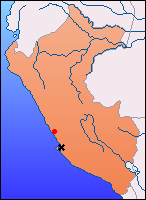 |
Associated Pages: |
 Located about 230 kilometers south of Lima, Pisco is a city known not only for its famous liquor but also for its rich history and proximity to some of the most spectacular natural landscapes in Peru. Founded in 1640, Pisco was an important port during colonial times, and its name comes from the grape brandy that has been produced in this region for centuries. Pisco, a national symbol, has been exported worldwide and is recognized for its quality and unique taste.
Located about 230 kilometers south of Lima, Pisco is a city known not only for its famous liquor but also for its rich history and proximity to some of the most spectacular natural landscapes in Peru. Founded in 1640, Pisco was an important port during colonial times, and its name comes from the grape brandy that has been produced in this region for centuries. Pisco, a national symbol, has been exported worldwide and is recognized for its quality and unique taste.
Although the vineyards that produce this liquor are a major attraction, Pisco is also a place of great historical significance. During the War of the Pacific, it was here that Peru's defense was organized, and Pisco's port was a key supply point. Over the centuries, the city has witnessed many historical events that have left their mark on its architecture and culture. Despite the damage caused by the 2007 earthquake, Pisco has managed to retain its authentic character, with streets still steeped in a colonial atmosphere.
Just a few kilometers from Pisco lies the spectacular Paracas National Reserve, one of the most important protected areas in the country. Known for its breathtaking desert landscapes that meet the Pacific Ocean, this reserve is a paradise for nature lovers. Here, visitors can observe an astonishing biodiversity that includes flamingos, pelicans, sea lions, and even dolphins at certain times of the year. Paracas is also home to archaeological remains dating back to pre-Inca times, adding a cultural dimension to the natural experience.
Tours of the reserve offer visitors the opportunity to explore this unique ecosystem where desert and sea combine in a dramatic way. There are several hiking trails as well as cycling routes for those seeking a more active experience. The beaches of the reserve, such as Playa Roja and Lagunillas, are perfect for relaxing and enjoying the scenery. During the visit, don't miss a stop at the reserve's interpretation center, where you can learn more about the flora, fauna, and the importance of conservation in this area.
Pisco is also the starting point for excursions to the Ballestas Islands, known for their incredible marine wildlife. Often referred to as the "poor man's Galapagos" due to their accessibility, these islands are home to colonies of sea lions, Humboldt penguins, cormorants, boobies, and many other species of seabirds. A boat tour allows visitors to get up close to these animals in their natural habitat and enjoy an unforgettable spectacle. The rocky formations of the islands, sculpted by wind and sea, add scenic beauty to the visit. On the way to the islands, you can also observe the mysterious geoglyph known as the Candelabra, a giant figure etched into a hillside.
In addition to its natural attractions, Pisco offers a rich culinary tradition. The local restaurants are famous for their seafood dishes, including ceviche and tiraditos. Another typical dish is arroz con mariscos, a delicious combination of seafood and flavorful rice. And of course, no visit to Pisco would be complete without trying a Pisco Sour, Peru's national cocktail. This delightful drink, made with pisco, lime juice, sugar, and egg white, is the perfect complement to a meal by the sea.
The historic center of Pisco, though affected by the 2007 earthquake, remains a place of great interest for visitors. Here, you can find ancient churches, colonial houses, and plazas filled with history. One of the most iconic squares is the Plaza de Armas, where various cultural events are held throughout the year. The city is also home to several monuments dedicated to important historical figures, such as José de San Martín, who proclaimed Peru's independence from the beaches of Paracas.
Visiting Pisco is an experience that combines history, culture, and nature. To make the most of your stay, it's recommended to book a boat excursion to the Ballestas Islands early in the morning, when the sea is calmer. It is essential to bring comfortable clothing, sunscreen, and water, as the weather can be hot and sunny. Also, don't forget to explore the local vineyards and participate in a pisco tasting to learn about the process of making this iconic liquor.
With its stunning landscapes, rich history, and delicious gastronomy, Pisco is a destination that offers a complete experience for travelers looking to explore Peru's southern coast.